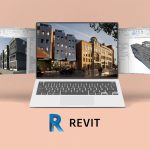Revit has revolutionized the architecture, engineering, and construction (AEC) industries. It’s become an important tool, and even designers, particularly interior designers use it regularly. But what is Revit used for in the world of interior design?
Revit is important to interior design because it enables professionals to design and create 3D models of interior spaces, allowing for more accurate visualizations that will translate well from a computer to real life. If you’re in the interior design business, you’ll want to hire Revit designers who are adept in the use of the program so that you can deliver high-quality designs and iterations to clients efficiently.
What Is Revit?
Revit is a building information modeling (BIM) software that enables interior designers to create accurate and detailed representations of interior spaces, which can be used to help clients and stakeholders better visualize and understand interior design.
With a variety of tools, Revit allows design professionals to draft layouts with walls, floors, ceilings, doors, windows, and other interior architectural elements, including furniture placement, lighting plans, and material schedules. It also enables improved interior design documentation, which makes coordination with builders and contractors more streamlined.
Why Revit Is Important to Interior Design
Revit is a necessary software in an interior designer’s toolbelt. Here are some of the reasons why it’s so important to interior design:
Space Planning
Interior designers can use Revit to build three-dimensional models of interior spaces, which helps in planning spaces and laying out furniture. The software is valuable in the process of making detailed representations of designed spaces.
Visualization
Interior designers can utilize Revit to give clients a better visual and understanding of their design intent. They can even use the program to create virtual walkthroughs!
Multi-Discipline Coordination
Revit allows for multi-discipline coordination, so outputs can seamlessly be cascaded to other team members on the project like architects, engineers, and contractors, making projects more transparent and seamless. This feature is also one of the key points to address the question, “why choose Revit in structural design?”
Material Flexibility
Revit gives interior designers access to a wide range of material schedules and specifications, which is useful in selecting what’s needed for the project while ensuring that it complies with the design brief and budget.
Documentation
Interior designers can generate detailed documentation, such as floor plans, sections, and schedules, on Revit that they can give to contractors and builders for more precise interior space production.
Benefits of Using Revit for Interior Design
Revit can greatly aid interior designers to craft designs and draft builds with great precision and visual value. Here are some advantages of using Revit for interior design:
Precise and Realistic 3D Modeling
Interior designers can better visualize spaces and make informed decisions about design and layout because Revit can build precise models that can be easily visualized realistically.
Efficient Tools
Revit has a suite of tools that help interior designers work more efficiently. These include pre-built components, analysis tools, and automation features, all of which can streamline workflows, saving businesses time and resources.
Improved Collaboration
As a multi-disciplinary software, Revit allows interior designers to work with other AEC professionals in real-time. Tasks can be shared and feedback can be instantly given, making the whole design and production process more coherent.
What Is a Revit Designer?
A Revit designer is an expert in the use of Revit software; a professional who knows how to use its tools to design and build 3D models of structures and spaces. They are typically someone with a background in AEC and a familiarity with building codes, construction methods, and design principles.
What Does a Revit Designer Do?
A Revit designer for interior design is primarily responsible for creating detailed 3D models of interior spaces or someone that assists an interior designer in these tasks. They develop design concepts and translate them into the software, all while producing construction documentation and collaborating with other team members and stakeholders.
A Revit designer is also often tasked to perform quality control analysis on built models and to resolve any design conflicts that arise. They’ll aim to deliver the best outputs for clients based on a project brief and ensure that created designs translate well in real-life iterations.
Hire a Revit Designer on Guru
Businesses in the interior design industry will benefit from hiring a freelance Revit designer on Guru. They can provide expert support and help you accomplish projects through high-quality outputs. You can easily find the right one for you on Guru—and you can hire them in just a couple of clicks, as well as manage the entire job project on the platform!



